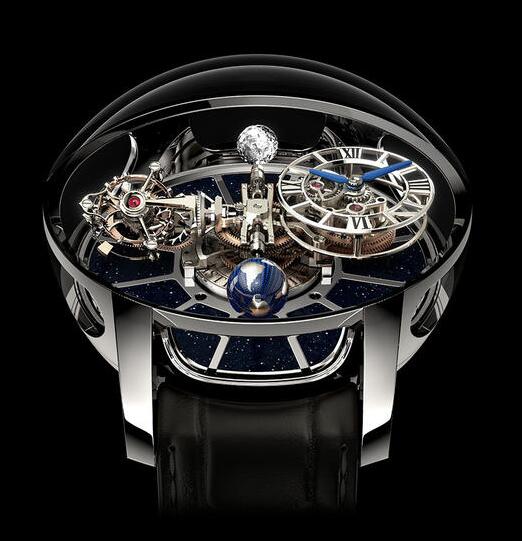Jacob & Co. Astronomy

Lots of mechanical fireworks and real-time snapshots of the night sky.
Jacob’s unique astronomical tourbillon series creates astronomical complications. In general, they are not meant to represent the actual astronomical period with high accuracy (this is the most complicated example of a watch, now it may be Vacheron Constantin’s Celestia). Instead, they are a kind of dynamic sculpture of the wrist, based on a four-arm bracket system, which supports various additional displays or representations of celestial bodies.
Astronomia watches also have a very thick case and high domed crystals, which highlight the three-dimensionality of the carrier structure (and provide a truly heavenly visual effect). Although we have said that in general, the precise celestial cycle is not what Jacobs pursues in these tables, but as far as the astronomical sky is concerned, it can very accurately indicate sidereal time and star elevation.
The entire bracket system rotates around the turntable every 20 minutes. At the end of each arm, there is a clockwise moving dial to show the time; a stylized rocket ship running seconds indicator that rotates around its own axis once per minute; a dual-axis tourbillon (on a planet carrier system) Add the center of rotation, which is actually a three-axis tourbillon) and a rotating globe cut from orange sapphire.
The dial showing the time is fixed to the differential system, so it always faces upward regardless of the position of the bracket mounted on it. Behind it, you can see the central globe, which rotates in a colored sapphire hemisphere (the globe is hand-engraved titanium and rotates once every 24 hours).
The tourbillon rotates around its innermost axis every 60 seconds and around the outer axis every five minutes (of course, it rotates three times inside the watch every hour).
The original astronomy has a spherical faceted diamond, here, in the sky, you will see orange sapphires. The idea of the diamond is that it is a stylized representation of the moon. Orange sapphire exempts this similarity, but you can do this because its rotation period is not designed to simulate any particular celestial body, so you can pretend it is an orange planet or star of your choice (I will go to Mars myself… It seems to be used with the rocket ship on the opposite vehicle). The gem has 288 facets, and the cut was developed specifically for gems used in astronomy and has actually been patented. Since the central stand rotates every 20 minutes, the watch will look different every time you look at it. If you wear it on your wrist, you might look at it often.
Now, we did mention that astronomical watches are usually not about astronomically accurate celestial cycles? However, the sky of astronomy does contain the real-time complexity of stars. You can find it on the dark blue titanium dial with its constellations and 18k gold stars. Once every sidereal day, the oval that represents the horizon rotates around the dial, and the stars and constellations that appear inside the dial are those currently visible above the head.
Considering its size and complexity, you might think Astronomia Sky is a bulky watch. It is definitely not lightweight (in any sense), but it is much more wear-resistant than you think, partly because the main body of the watch is mostly made of lightweight materials (such as titanium and sapphire). .
This minimalist watchmaking craft is something that people often tried a decade or so ago, but it takes a lot of energy to make it work, and you must have something that truly exceeds what many people think you have Talent, but this is not the case. It also helps if there is some real technical interest behind the watch. It is much harder to get all these relatively large components to work together on the stand system than it is to imagine the visually spectacular end result. As a pure performance technique, there is hardly anything comparable to the astronomical sky. I found this particular model (with stellar day, year and star chart indications) to be the most compelling version to date.
Astronomical Sky: Designed by Jacob Arabo in collaboration with Studio 7h38. Movement, the unique (obviously) manual winding movement JCAM11; 40mm x 17.15mm (titanium main panel). It has a frequency of 21,600 vph, runs 42 jewels, and has a three-axis tourbillon. Power reserve, 60 hours. Sidereal day and year display, with year and month indication; night sky indication. The lacquered hand-carved titanium ball rotates every 24 hours. 1 carat “Jacob Cut” orange sapphire with 228 facets. Case, 47 mm x 25 mm, rose gold, with sapphire glass window; domed sapphire crystal with anti-reflective coating. The waterproof depth is 30 meters.